Gallery
Image Type
Morphological Structure
Clades
 Phytophthora cactorum (CPHST BL 9) sexual phase formed on V8 agar flooded with soil extract: (a) three oogonia with paragynous antheridia, in bottom abortive oogonium, (b) aplerotic oospore in smooth wall oogonium with paragynous antheridium, (c) plerotic oospore in smooth wall oogonium with tapered base and paragynous antheridium; photos (a) and (b) by V. Brewster, USDA-APHIS-PPQ and (c) by G. Abad, USDA-APHIS-PPQ
Phytophthora cactorum (CPHST BL 9) sexual phase formed on V8 agar flooded with soil extract: (a) three oogonia with paragynous antheridia, in bottom abortive oogonium, (b) aplerotic oospore in smooth wall oogonium with paragynous antheridium, (c) plerotic oospore in smooth wall oogonium with tapered base and paragynous antheridium; photos (a) and (b) by V. Brewster, USDA-APHIS-PPQ and (c) by G. Abad, USDA-APHIS-PPQ
Phytophthora cactorum (CPHST BL 9) sexual phase formed on V8 agar flooded with soil extract: (a) three oogonia with paragynous antheridia, in bottom abortive oogonium, (b) aplerotic oospore in smooth wall oogonium with paragynous antheridium, (c) plerotic oospore in smooth wall oogonium with tapered base and paragynous antheridium; photos (a) and (b) by V. Brewster, USDA-APHIS-PPQ and (c) by G. Abad, USDA-APHIS-PPQ
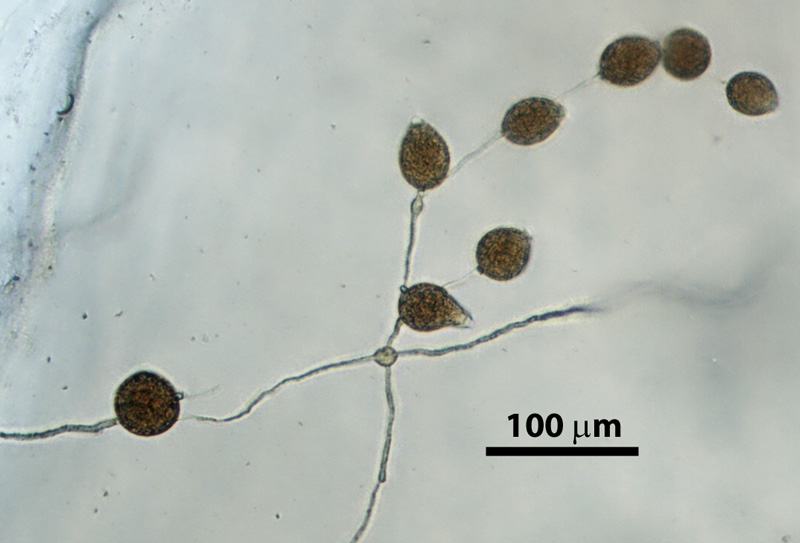 Phytophthora cactorum nbsp;(CPHST BL 9) asexual phase formed on V8 agar flooded with soil extract: sporangia originated in lax sympodial sporangiophore, chlamydospore in bottom left. Photo by G. Abad, USDA-APHIS-PPQ.
Phytophthora cactorum nbsp;(CPHST BL 9) asexual phase formed on V8 agar flooded with soil extract: sporangia originated in lax sympodial sporangiophore, chlamydospore in bottom left. Photo by G. Abad, USDA-APHIS-PPQ.
Phytophthora cactorum (CPHST BL 9) asexual phase formed on V8 agar flooded with soil extract: sporangia originated in lax sympodial sporangiophore, chlamydospore in bottom left. Photo by G. Abad, USDA-APHIS-PPQ.
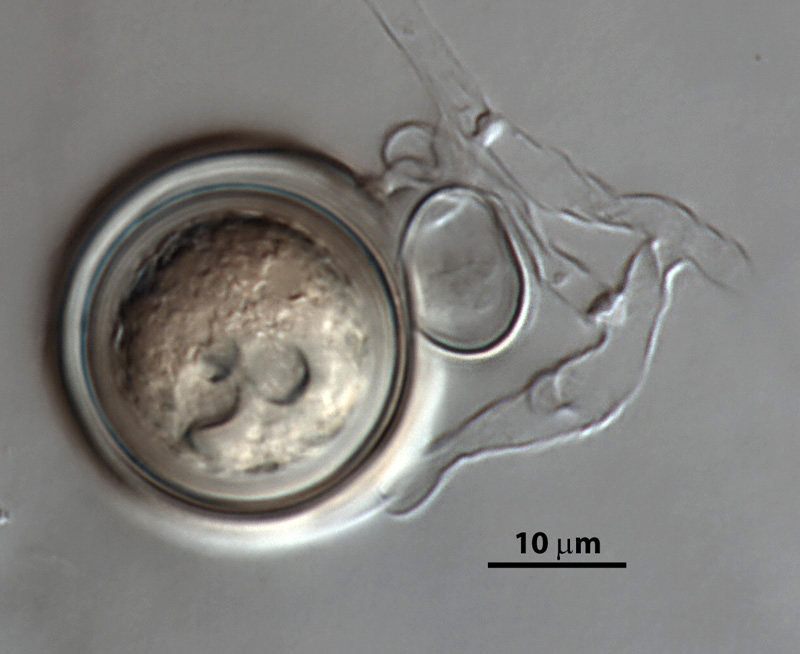 Phytophthora cactorum nbsp;(CPHST BL 9) sexual phase formed on V8 agar flooded with soil extract: aplerotic oospore in smooth wall oogonium with paragynous antheridium. Photo bynbsp;V. Brewster, USDA-APHIS-PPQ.
Phytophthora cactorum nbsp;(CPHST BL 9) sexual phase formed on V8 agar flooded with soil extract: aplerotic oospore in smooth wall oogonium with paragynous antheridium. Photo bynbsp;V. Brewster, USDA-APHIS-PPQ.
Phytophthora cactorum (CPHST BL 9) sexual phase formed on V8 agar flooded with soil extract: aplerotic oospore in smooth wall oogonium with paragynous antheridium. Photo by V. Brewster, USDA-APHIS-PPQ.
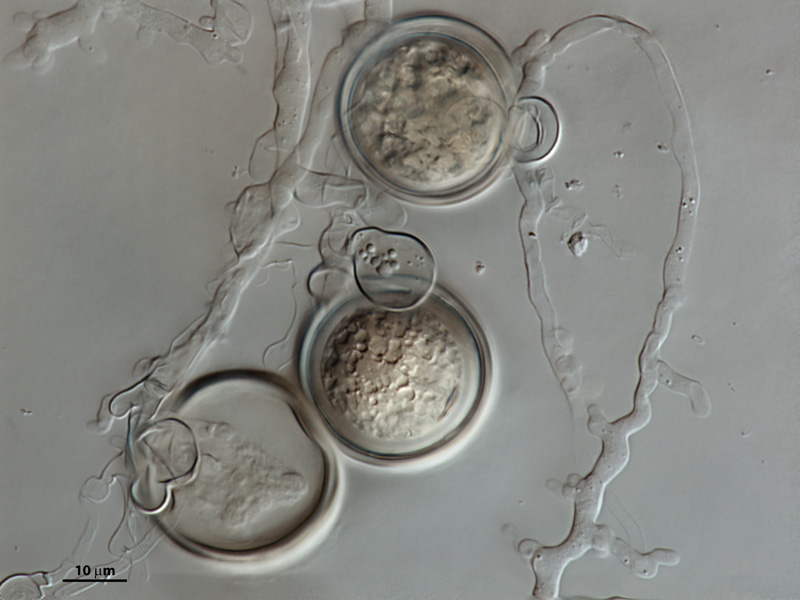 Phytophthora cactorum nbsp;(CPHST BL 9) sexual phase formed on V8 agar flooded with soil extract: three oogonia with paragynous antheridia, in bottom abortive oogonium.nbsp;Photo by V. Brewster, USDA-APHIS-PPQ.
Phytophthora cactorum nbsp;(CPHST BL 9) sexual phase formed on V8 agar flooded with soil extract: three oogonia with paragynous antheridia, in bottom abortive oogonium.nbsp;Photo by V. Brewster, USDA-APHIS-PPQ.
Phytophthora cactorum (CPHST BL 9) sexual phase formed on V8 agar flooded with soil extract: three oogonia with paragynous antheridia, in bottom abortive oogonium. Photo by V. Brewster, USDA-APHIS-PPQ.
 Phytophthora cactorum nbsp;(CPHST BL 9) asexual phase:nbsp;chlamydospore.nbsp;Photo by G. Abad, USDA-APHIS-PPQ.
Phytophthora cactorum nbsp;(CPHST BL 9) asexual phase:nbsp;chlamydospore.nbsp;Photo by G. Abad, USDA-APHIS-PPQ.
Phytophthora cactorum (CPHST BL 9) asexual phase: chlamydospore. Photo by G. Abad, USDA-APHIS-PPQ.
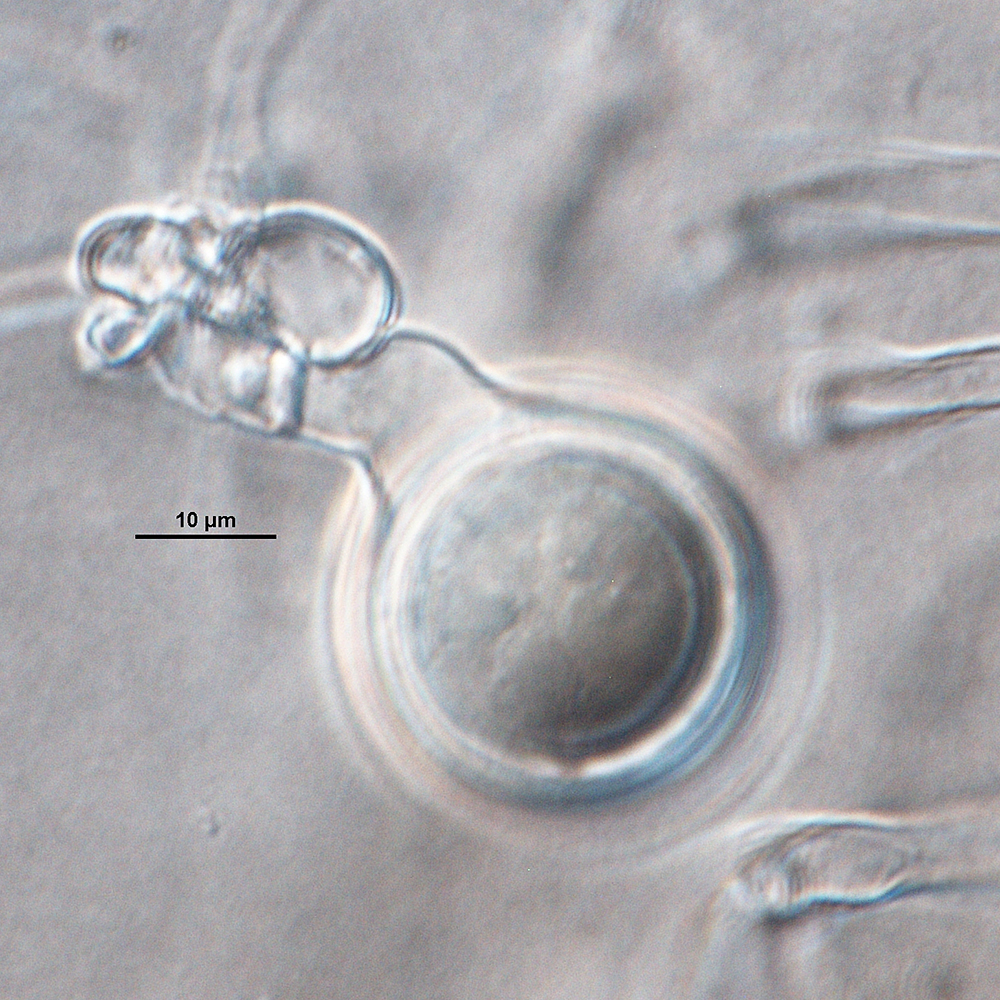 Phytophthora cactorum nbsp;(CPHST BL 9) sexual phase formed on V8 agar flooded with soil extract: plerotic oospore in smooth wall oogonium with tapered base and paragynous antheridium. Photo by G. Abad, USDA-APHIS-PPQ.
Phytophthora cactorum nbsp;(CPHST BL 9) sexual phase formed on V8 agar flooded with soil extract: plerotic oospore in smooth wall oogonium with tapered base and paragynous antheridium. Photo by G. Abad, USDA-APHIS-PPQ.
Phytophthora cactorum (CPHST BL 9) sexual phase formed on V8 agar flooded with soil extract: plerotic oospore in smooth wall oogonium with tapered base and paragynous antheridium. Photo by G. Abad, USDA-APHIS-PPQ.
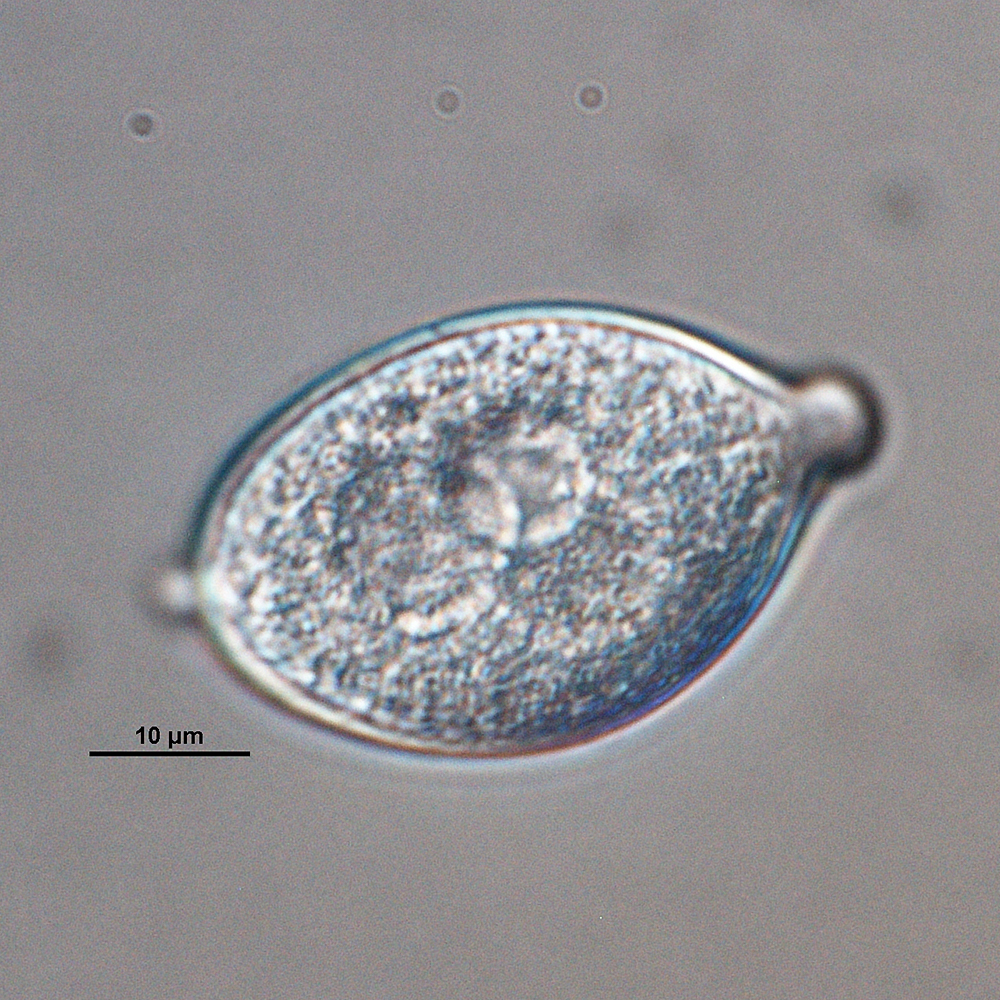 Phytophthora cactorum nbsp;(CPHST BL 9) asexual phase formed on V8 agar flooded with soil extract: papillate caducous sporangium with short pedicel. Photo by G. Abad, USDA-APHIS-PPQ.
Phytophthora cactorum nbsp;(CPHST BL 9) asexual phase formed on V8 agar flooded with soil extract: papillate caducous sporangium with short pedicel. Photo by G. Abad, USDA-APHIS-PPQ.
Phytophthora cactorum (CPHST BL 9) asexual phase formed on V8 agar flooded with soil extract: papillate caducous sporangium with short pedicel. Photo by G. Abad, USDA-APHIS-PPQ.
Phytophthora spp. in subclade 9d: portion of the seven-loci ML phylogeny featuring the type cultures of 212 described species (by T. Bourret). Notice the position of P. cacuminis Ex-type CBS 144709. Gloria Abad, USDA S&T.
Phytophthora spp. in subclade 9d: Morphological Tabular key (PDF) and Tabular key legends (PDF) in IDphy2 KEY SECTION. Notice the data of P. cacuminis Ex-type CBS 144709. Gloria Abad, USDA S&T.
 colony morphology after 5 d growth at 20ordm;C on carrot agar, V8 agar, malt extract agar, and potato-dextrose agar (from left to right)
colony morphology after 5 d growth at 20ordm;C on carrot agar, V8 agar, malt extract agar, and potato-dextrose agar (from left to right)
colony morphology after 5 d growth at 20ºC on carrot agar, V8 agar, malt extract agar, and potato-dextrose agar (from left to right)
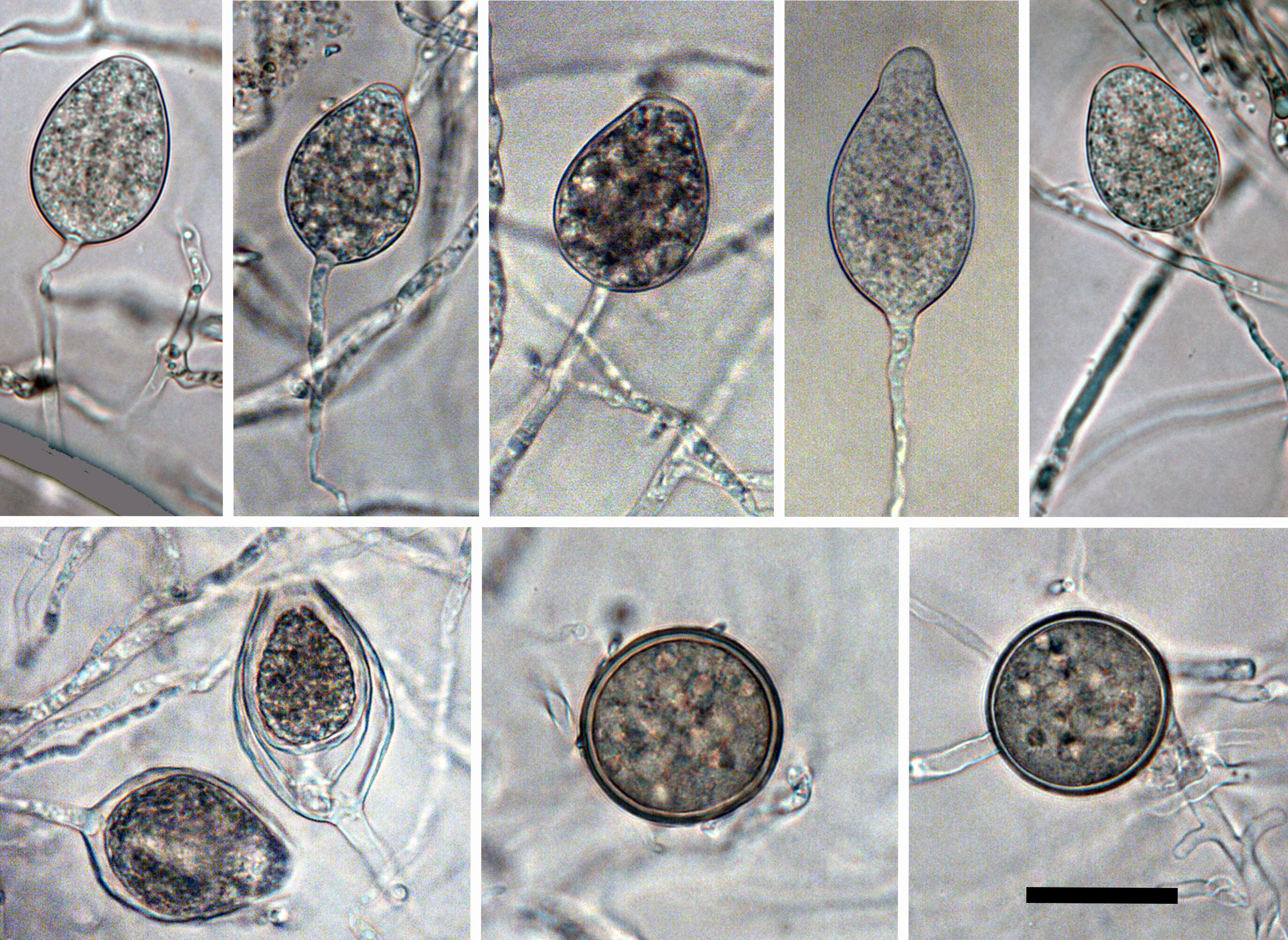 persistent, non-papillate, predominantly ovoid sporangia with internal proliferation;nbsp;chlamydospores are common; scale bar = 25micro;m
persistent, non-papillate, predominantly ovoid sporangia with internal proliferation;nbsp;chlamydospores are common; scale bar = 25micro;m
persistent, non-papillate, predominantly ovoid sporangia with internal proliferation; chlamydospores are common; scale bar = 25µm
Phytophthora spp. in subclade 7b: portion of the seven-loci ML phylogeny featuring the type cultures of 212 described species (by T. Bourret). Notice the position of P. cajani selected specimen ATCC 44388 = S&T BL 116. Gloria Abad, USDA S&T.
Phytophthora spp. in subclade 7b: Morphological Tabular key (PDF) and Tabular key legends (PDF) in IDphy2 KEY SECTION. Notice the data of P. cajani selected specimen ATCC 44388 = S&T BL 116. Gloria Abad, USDA S&T.
Phytophthora cajani, colony morphology after 7 days growth on (a) V8® agar (b) potato dextrose agar; photos by Yilmaz Balci, USDA-APHIS-PPQ
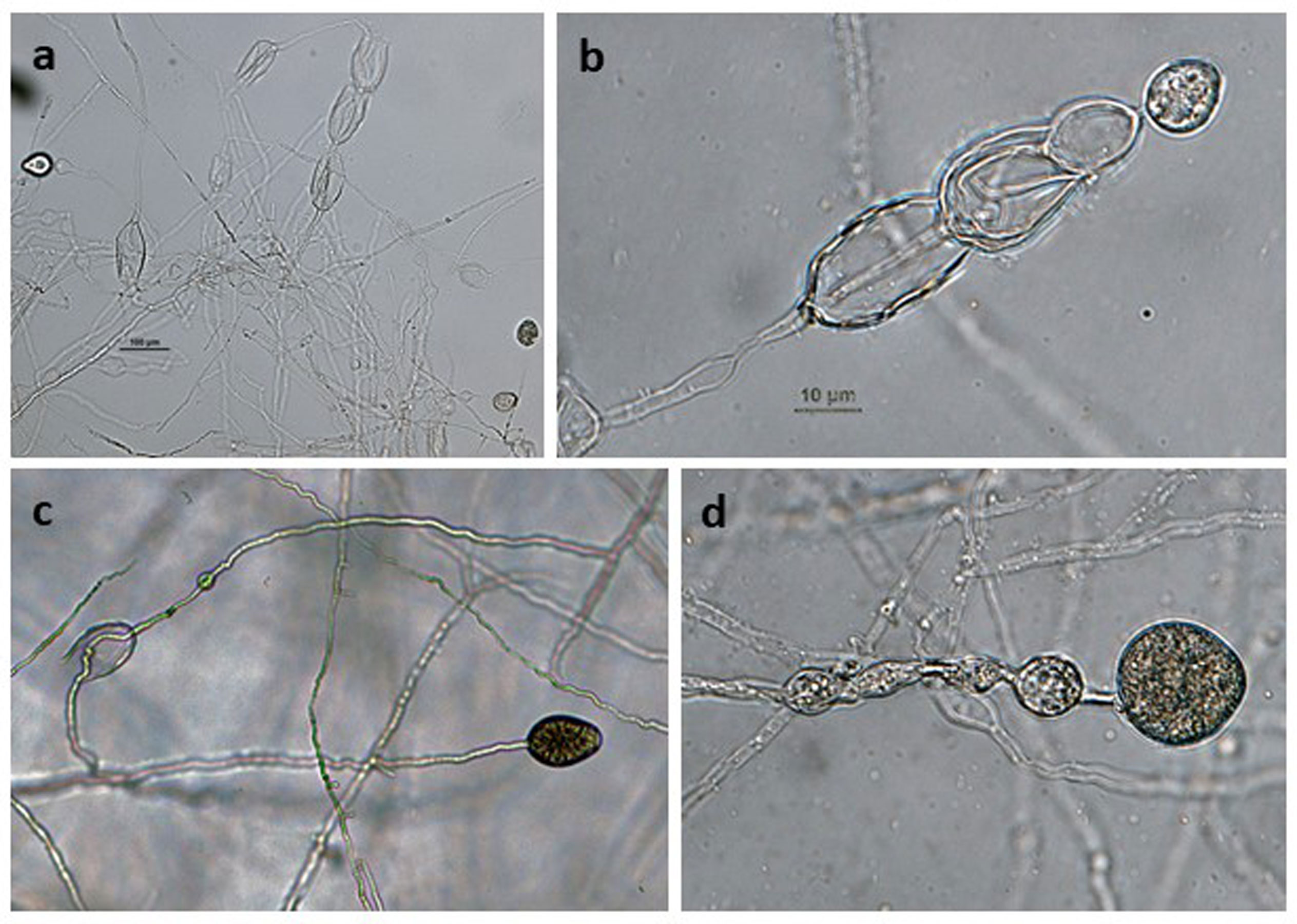 Phytophthora cajani (CPHST BL 116) asexual phase (andash;d): (andash;c) sporangiophores with internal proliferations, (c, d) nonpapillate persistent sporangium originated in unbranched sporangiophores and showing hyphal swellings; photos by Gloria Abad, USDA-APHIS-PPQ.
Phytophthora cajani (CPHST BL 116) asexual phase (andash;d): (andash;c) sporangiophores with internal proliferations, (c, d) nonpapillate persistent sporangium originated in unbranched sporangiophores and showing hyphal swellings; photos by Gloria Abad, USDA-APHIS-PPQ.
Phytophthora cajani (CPHST BL 116) asexual phase (a–d): (a–c) sporangiophores with internal proliferations, (c, d) nonpapillate persistent sporangium originated in unbranched sporangiophores and showing hyphal swellings; photos by Gloria Abad, USDA-APHIS-PPQ.
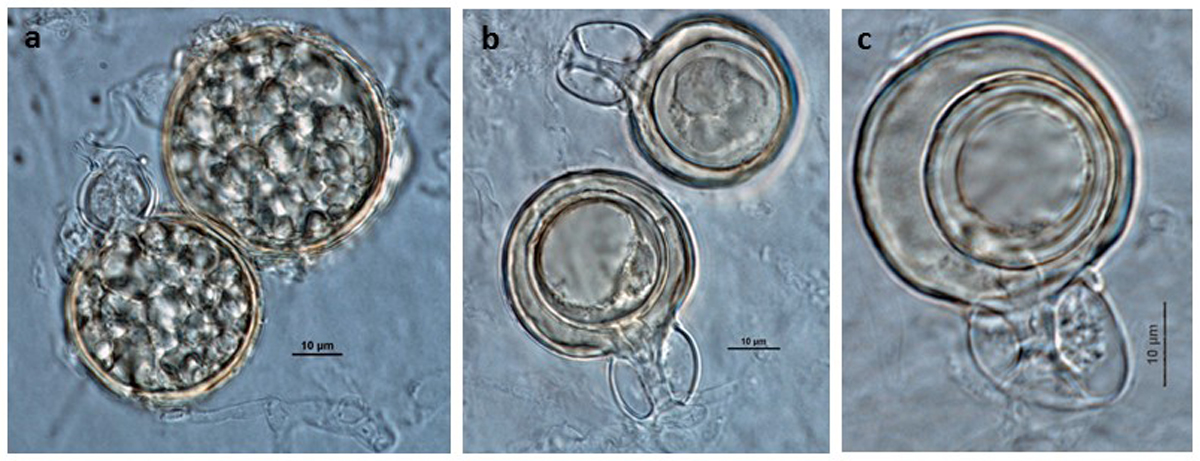 Phytophthora cajani (CPHST BL 116) sexual phase:nbsp;(a) young oogonia with no differentiated oospore,nbsp;(b-c) mature oogonia with amphigynous antheridia and markedly aplerotic oospores (compare with figures in original publication Amin et al. 1978); photos by Gloria Abad, USDA-APHIS-PPQ.
Phytophthora cajani (CPHST BL 116) sexual phase:nbsp;(a) young oogonia with no differentiated oospore,nbsp;(b-c) mature oogonia with amphigynous antheridia and markedly aplerotic oospores (compare with figures in original publication Amin et al. 1978); photos by Gloria Abad, USDA-APHIS-PPQ.
Phytophthora cajani (CPHST BL 116) sexual phase: (a) young oogonia with no differentiated oospore, (b-c) mature oogonia with amphigynous antheridia and markedly aplerotic oospores (compare with figures in original publication Amin et al. 1978); photos by Gloria Abad, USDA-APHIS-PPQ.
 Phytophthora cajani nbsp;(CPHST BL 116) asexual phase: non-papillate persistent sporangium originated in unbranched sporangiophore and showing hyphal swellings; photonbsp;by Gloria Abad, USDA-APHIS-PPQ.
Phytophthora cajani nbsp;(CPHST BL 116) asexual phase: non-papillate persistent sporangium originated in unbranched sporangiophore and showing hyphal swellings; photonbsp;by Gloria Abad, USDA-APHIS-PPQ.
Phytophthora cajani (CPHST BL 116) asexual phase: non-papillate persistent sporangium originated in unbranched sporangiophore and showing hyphal swellings; photo by Gloria Abad, USDA-APHIS-PPQ.
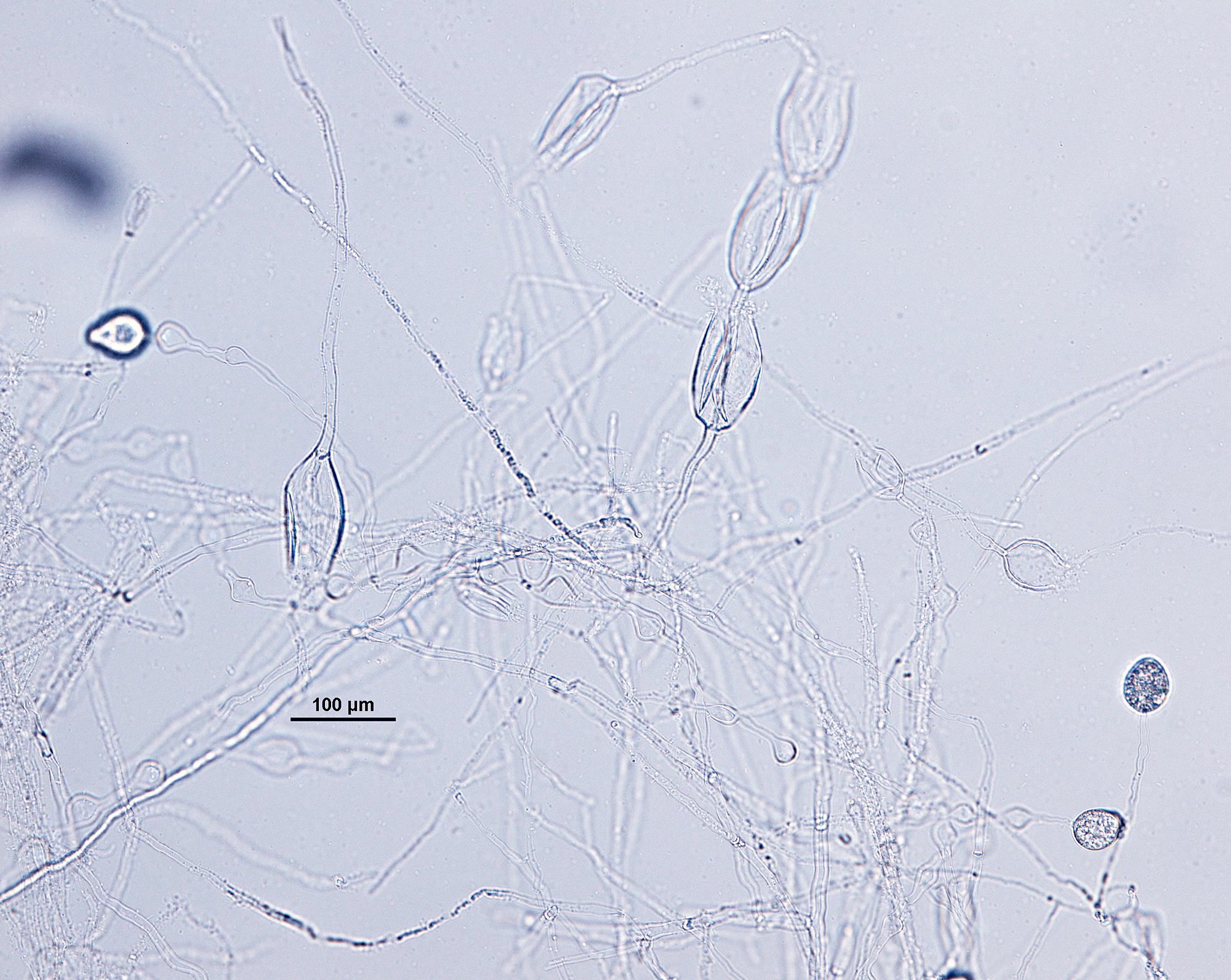 Phytophthora cajani nbsp;(CPHST BL 116) asexual phase): sporangiophores with internal proliferations; photos by Gloria Abad, USDA-APHIS-PPQ.
Phytophthora cajani nbsp;(CPHST BL 116) asexual phase): sporangiophores with internal proliferations; photos by Gloria Abad, USDA-APHIS-PPQ.
Phytophthora cajani (CPHST BL 116) asexual phase): sporangiophores with internal proliferations; photos by Gloria Abad, USDA-APHIS-PPQ.
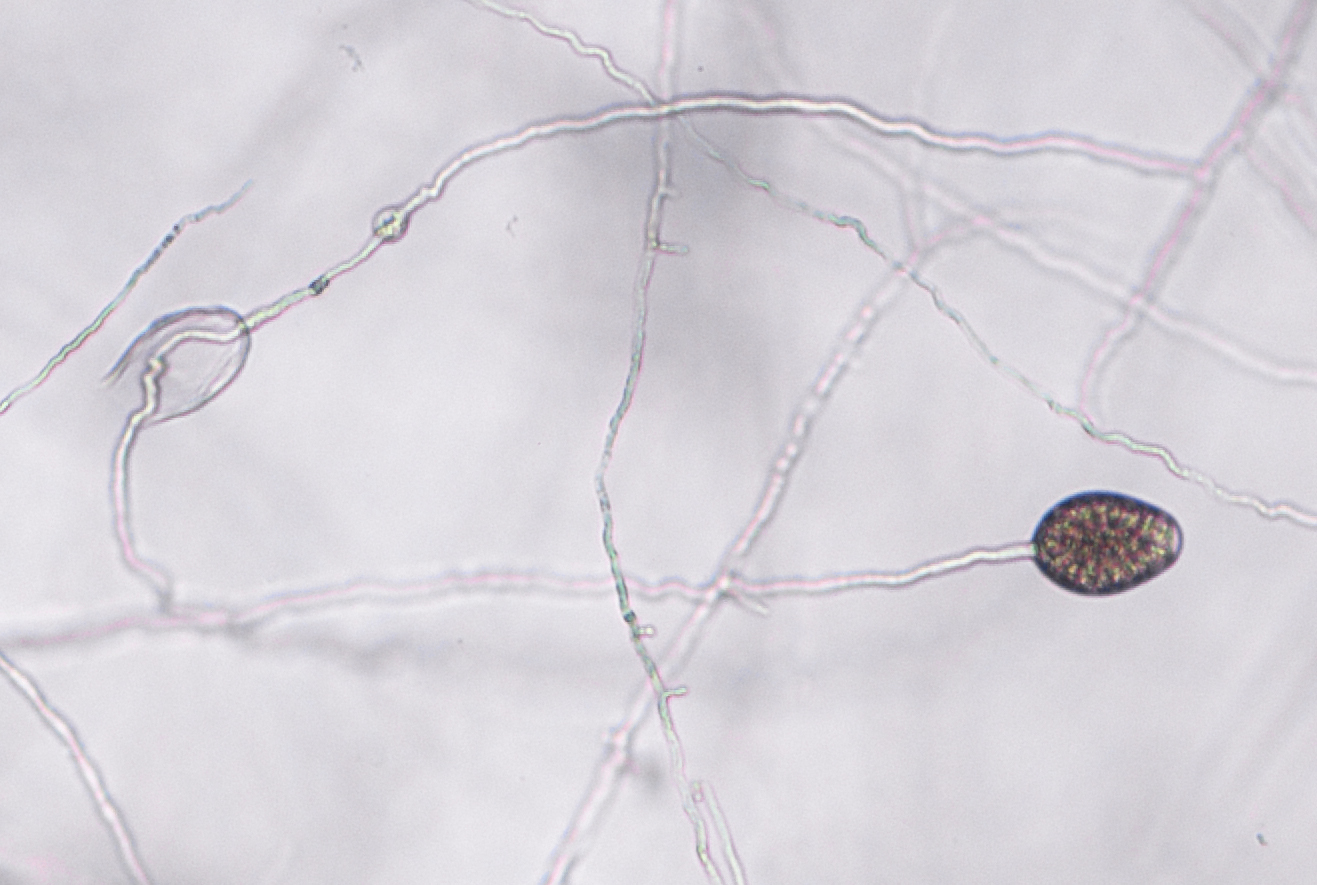 Phytophthora cajani nbsp;(CPHST BL 116) asexual phase: sporangiophores with internal proliferation. Non-papillate persistent sporangium originated in unbranched sporangiophores, hyphal swelling present; photo by Gloria Abad, USDA-APHIS-PPQ.
Phytophthora cajani nbsp;(CPHST BL 116) asexual phase: sporangiophores with internal proliferation. Non-papillate persistent sporangium originated in unbranched sporangiophores, hyphal swelling present; photo by Gloria Abad, USDA-APHIS-PPQ.
Phytophthora cajani (CPHST BL 116) asexual phase: sporangiophores with internal proliferation. Non-papillate persistent sporangium originated in unbranched sporangiophores, hyphal swelling present; photo by Gloria Abad, USDA-APHIS-PPQ.
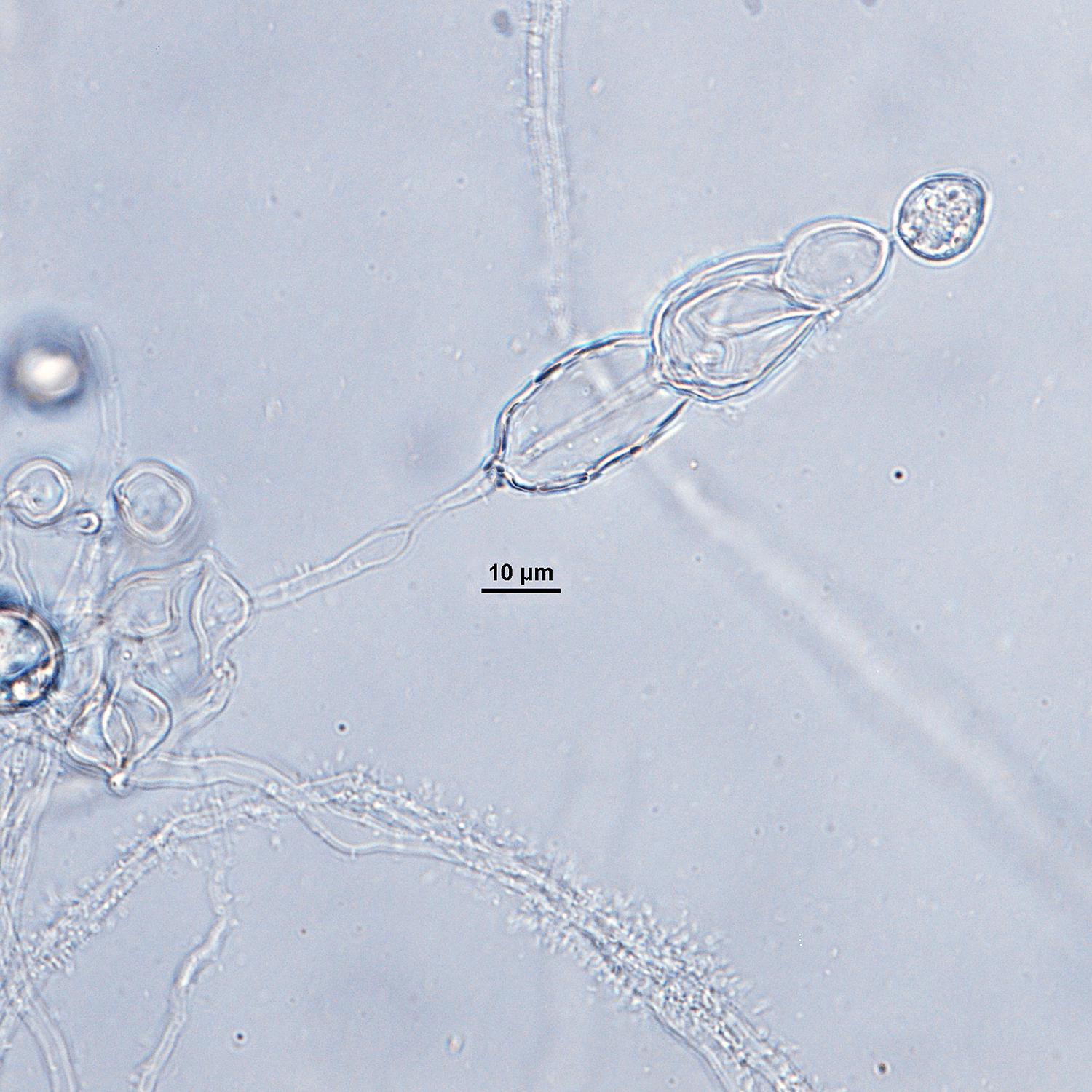 Phytophthora cajani nbsp;(CPHST BL 116) asexual phase: sporangiophores with internal proliferations;nbsp;hyphal swellings also present; photonbsp;by Gloria Abad, USDA-APHIS-PPQ.
Phytophthora cajani nbsp;(CPHST BL 116) asexual phase: sporangiophores with internal proliferations;nbsp;hyphal swellings also present; photonbsp;by Gloria Abad, USDA-APHIS-PPQ.
Phytophthora cajani (CPHST BL 116) asexual phase: sporangiophores with internal proliferations; hyphal swellings also present; photo by Gloria Abad, USDA-APHIS-PPQ.
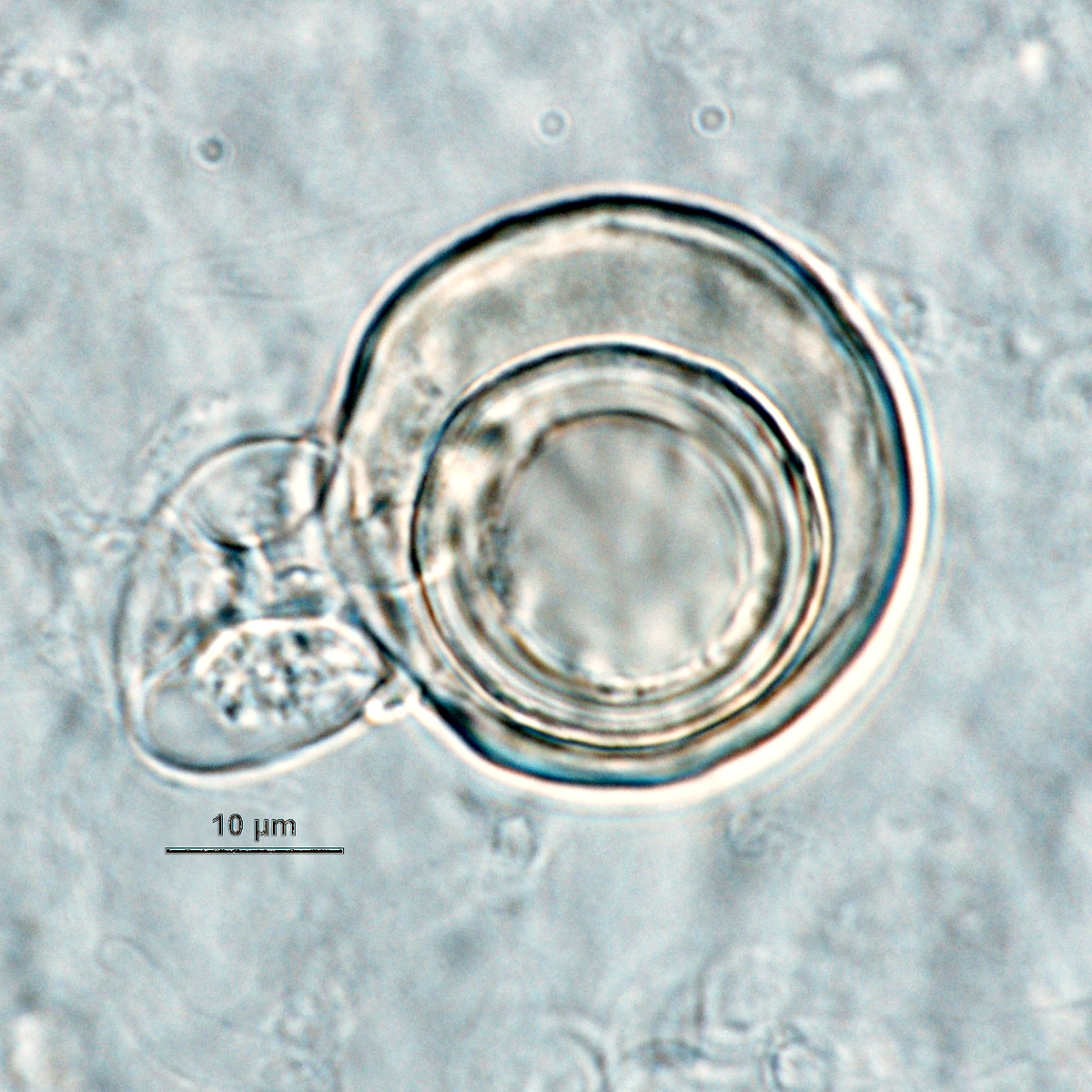 Phytophthora cajani nbsp;(CPHST BL 116) sexual phase:nbsp;mature oogoniumnbsp;with amphigynous antheridiumnbsp;and markedly aplerotic oosporenbsp;(compare with figures in original publication Amin et al. 1978); photonbsp;by Gloria Abad, USDA-APHIS-PPQ.
Phytophthora cajani nbsp;(CPHST BL 116) sexual phase:nbsp;mature oogoniumnbsp;with amphigynous antheridiumnbsp;and markedly aplerotic oosporenbsp;(compare with figures in original publication Amin et al. 1978); photonbsp;by Gloria Abad, USDA-APHIS-PPQ.
Phytophthora cajani (CPHST BL 116) sexual phase: mature oogonium with amphigynous antheridium and markedly aplerotic oospore (compare with figures in original publication Amin et al. 1978); photo by Gloria Abad, USDA-APHIS-PPQ.
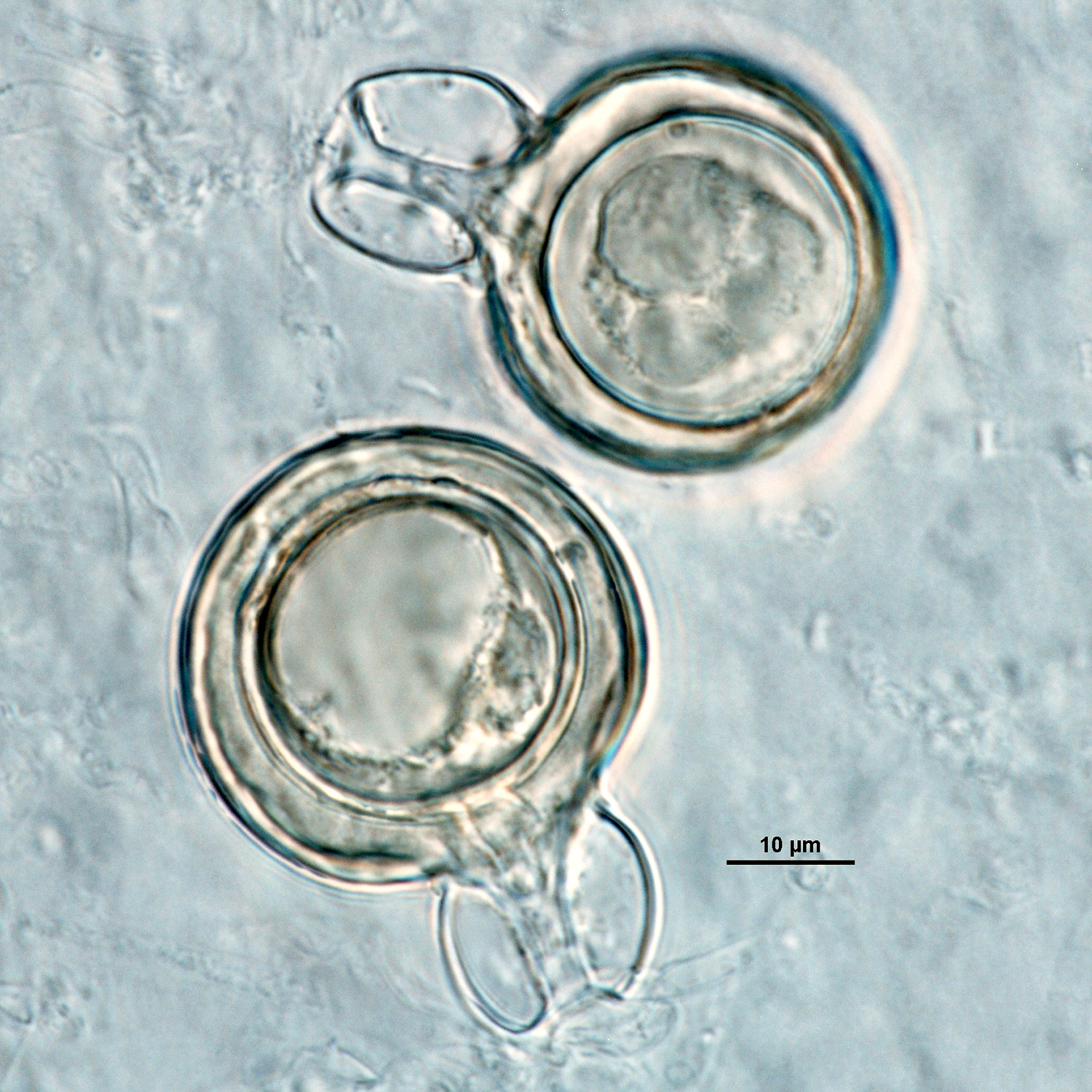 Phytophthora cajani nbsp;(CPHST BL 116) sexual phase:nbsp;mature oogonia with amphigynous antheridia and markedly aplerotic oospores (compare with figures in original publication Amin et al. 1978); photonbsp;by Gloria Abad, USDA-APHIS-PPQ.
Phytophthora cajani nbsp;(CPHST BL 116) sexual phase:nbsp;mature oogonia with amphigynous antheridia and markedly aplerotic oospores (compare with figures in original publication Amin et al. 1978); photonbsp;by Gloria Abad, USDA-APHIS-PPQ.
Phytophthora cajani (CPHST BL 116) sexual phase: mature oogonia with amphigynous antheridia and markedly aplerotic oospores (compare with figures in original publication Amin et al. 1978); photo by Gloria Abad, USDA-APHIS-PPQ.
 Phytophthora cajani nbsp;(CPHST BL 116) sexual phase:nbsp;young oogonianbsp;with no differentiated oospores; photo by Gloria Abad, USDA-APHIS-PPQ.
Phytophthora cajani nbsp;(CPHST BL 116) sexual phase:nbsp;young oogonianbsp;with no differentiated oospores; photo by Gloria Abad, USDA-APHIS-PPQ.
Phytophthora cajani (CPHST BL 116) sexual phase: young oogonia with no differentiated oospores; photo by Gloria Abad, USDA-APHIS-PPQ.
Phytophthora spp. in subclade 2c: portion of the seven-loci ML phylogeny featuring the type cultures of 212 described species (by T. Bourret). Notice the position of P. capensis Ex-type CBS 128319 = S&T BL 10. Gloria Abad, USDA S&T.
Phytophthora spp. in subclade 2c: Morphological Tabular key (PDF) and Tabular key legends (PDF) in IDphy2 KEY SECTION. Notice the data of P. capensis Ex-type CBS 128319 = S&T BL 10. Gloria Abad, USDA S&T.
Phytophthora spp. in subclade 2b: portion of the seven-loci ML phylogeny featuring the type cultures of 212 described species (by T. Bourret). Notice the position of P. capsici Ex-type CBS 128.23 = S&T BL 33G. Gloria Abad, USDA S&T.
Phytophthora spp. in subclade 2b: Morphological Tabular key (PDF) and Tabular key legends (PDF) in IDphy2 KEY SECTION. Notice the data of P. capsici Ex-type CBS 128.23 = S&T BL 33G. Gloria Abad, USDA S&T.
 Phytophthora capsici (CPHST BL 33) colonies of the ex-type grown for 7 days on (a) V8reg; Agar, (b) potato dextrose agar, and (c) malt extract agar; photo by Krysta Jennings and Leandra Knight, USDA-APHIS-PPQ
Phytophthora capsici (CPHST BL 33) colonies of the ex-type grown for 7 days on (a) V8reg; Agar, (b) potato dextrose agar, and (c) malt extract agar; photo by Krysta Jennings and Leandra Knight, USDA-APHIS-PPQ
Phytophthora capsici (CPHST BL 33) colonies of the ex-type grown for 7 days on (a) V8® Agar, (b) potato dextrose agar, and (c) malt extract agar; photo by Krysta Jennings and Leandra Knight, USDA-APHIS-PPQ
 Phytophthora capsici (CPHST BL 136) colonies of a selected specimen grown for 7 days on (a) V8reg; Agar, (b) potato dextrose agar, and (c) malt extract agar; photo by Krysta Jennings and Leandra Knight, USDA-APHIS-PPQ
Phytophthora capsici (CPHST BL 136) colonies of a selected specimen grown for 7 days on (a) V8reg; Agar, (b) potato dextrose agar, and (c) malt extract agar; photo by Krysta Jennings and Leandra Knight, USDA-APHIS-PPQ
Phytophthora capsici (CPHST BL 136) colonies of a selected specimen grown for 7 days on (a) V8® Agar, (b) potato dextrose agar, and (c) malt extract agar; photo by Krysta Jennings and Leandra Knight, USDA-APHIS-PPQ
 Phytophthora capsici nbsp;(ex-type CPHST BL 33) heterothallic sexual phase: (a, c) young oogonia with amphigynous antheridia, (d, e) smooth-walled oogonia with amphigynous antheridia (d, e), aplerotic oospore (d), plerotic oospore (e); photos by Gloria Abad, USDA-APHIS-PPQ.
Phytophthora capsici nbsp;(ex-type CPHST BL 33) heterothallic sexual phase: (a, c) young oogonia with amphigynous antheridia, (d, e) smooth-walled oogonia with amphigynous antheridia (d, e), aplerotic oospore (d), plerotic oospore (e); photos by Gloria Abad, USDA-APHIS-PPQ.
Phytophthora capsici (ex-type CPHST BL 33) heterothallic sexual phase: (a, c) young oogonia with amphigynous antheridia, (d, e) smooth-walled oogonia with amphigynous antheridia (d, e), aplerotic oospore (d), plerotic oospore (e); photos by Gloria Abad, USDA-APHIS-PPQ.
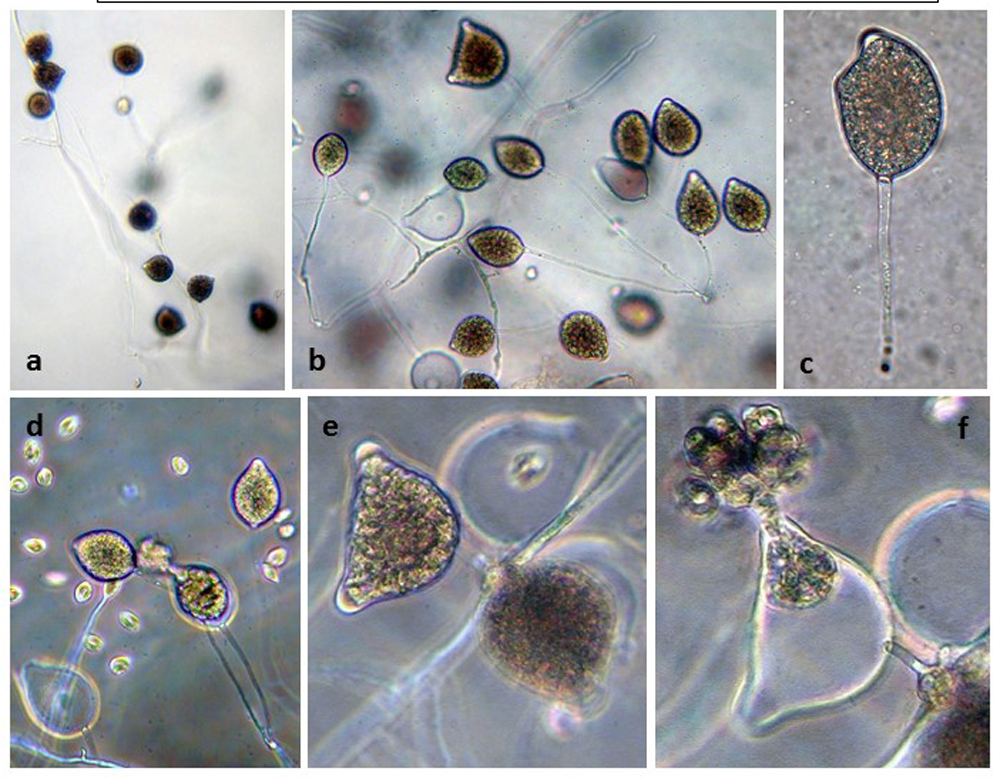 Phytophthora capsici (selected specimen P223): (a) sporangia originated in unbranched and simple sympodial sporangiophores, (b) sporangia originated in unbranched and irregular branched sporangiophores, (2) semipapillate ellipsoid caducous sporangium with long pedicel, (d-f) zoospores produced from semipapillated or bipapillate sporangia; photos by Gloria Abad, USDA-APHIS-PPQ
Phytophthora capsici (selected specimen P223): (a) sporangia originated in unbranched and simple sympodial sporangiophores, (b) sporangia originated in unbranched and irregular branched sporangiophores, (2) semipapillate ellipsoid caducous sporangium with long pedicel, (d-f) zoospores produced from semipapillated or bipapillate sporangia; photos by Gloria Abad, USDA-APHIS-PPQ
Phytophthora capsici (selected specimen P223): (a) sporangia originated in unbranched and simple sympodial sporangiophores, (b) sporangia originated in unbranched and irregular branched sporangiophores, (2) semipapillate ellipsoid caducous sporangium with long pedicel, (d-f) zoospores produced from semipapillated or bipapillate sporangia; photos by Gloria Abad, USDA-APHIS-PPQ
 P. capsici (ex-type CPHST BL 33): (a, b) sporangia formed in unbranched and irregular branched sporangiophores, (c) semipapillate ellipsoid sporangium with short pedicel, (d) papillate subglobose sporangium with short pedicel, (e) semipapillate pyriform sporangium with medium pedicel, (f) semipapillate distorted shape sporangium with medium pedicel, (g) semipapillate distorted shape sporangium with long pedicel; photos by Gloria Abad, USDA-APHIS-PPQ.
P. capsici (ex-type CPHST BL 33): (a, b) sporangia formed in unbranched and irregular branched sporangiophores, (c) semipapillate ellipsoid sporangium with short pedicel, (d) papillate subglobose sporangium with short pedicel, (e) semipapillate pyriform sporangium with medium pedicel, (f) semipapillate distorted shape sporangium with medium pedicel, (g) semipapillate distorted shape sporangium with long pedicel; photos by Gloria Abad, USDA-APHIS-PPQ.
P. capsici (ex-type CPHST BL 33): (a, b) sporangia formed in unbranched and irregular branched sporangiophores, (c) semipapillate ellipsoid sporangium with short pedicel, (d) papillate subglobose sporangium with short pedicel, (e) semipapillate pyriform sporangium with medium pedicel, (f) semipapillate distorted shape sporangium with medium pedicel, (g) semipapillate distorted shape sporangium with long pedicel; photos by Gloria Abad, USDA-APHIS-PPQ.

